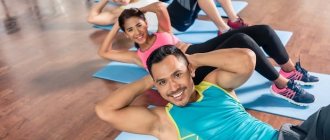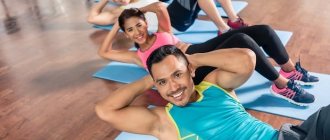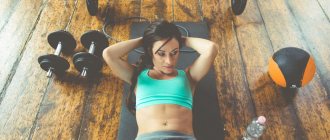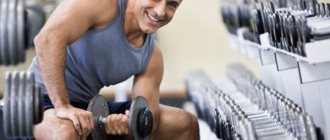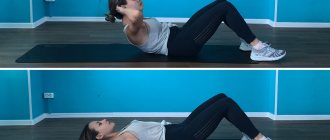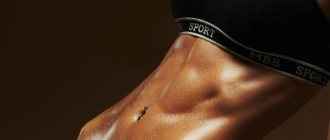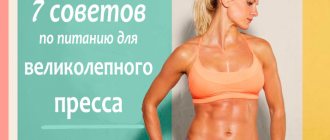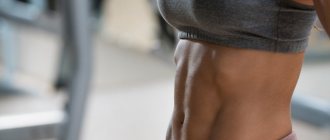Share:
The press is a relatively small muscle group. For this reason, it can be trained almost anywhere: at home, on the sports field, in the gym. There are a huge variety of exercises for this: from simple hanging leg raises, which everyone remembers from physical education lessons at school, to technically complex isolated movements like crunches from the upper block. Each exercise is slightly different in biomechanics and has its own specific execution. You can carry out both strength and more repetitive work aimed at increasing blood supply to the abdominal muscles. All load options have a place in your training process.
In our article today, we will look at the best abdominal exercises in the gym that are most relevant for CrossFit athletes and tell you how to do them correctly.
Anatomy of the abdominal muscles
Contrary to popular misconception, the abs do not consist of “cubes” separated from each other, which can be pumped up individually at any time. The abdominal muscles usually refer to the rectus, oblique and transverse abdominal muscles.
Rectus abdominis muscle
The rectus abdominis muscle is quite large and makes up about 80% of the abdominal volume. Tendons cross it across it, due to which “cubes” are visually created. We pump up the abs, the rectus abdominis muscle hypertrophies, the tendons are “pressed” inward. Due to this, relief appears. Of course, all this is permissible only with a small percentage of fatty tissue in the body.
The rectus abdominis muscle performs a number of important anatomical functions: supporting the back in an upright position, bending forward, supporting internal organs. In the fitness environment, it is customary to roughly divide the rectus abdominis muscle into two parts: upper and lower. This is not entirely correct from a medical point of view, but it works. The upper part is loaded with various variants of twisting and lifting the body, the lower part is loaded with leg lifts. Taken together, this gives a good impetus to progress.
Oblique muscles
The external oblique muscles of the abdomen are located on the sides, at the lower part of the waist. These are two small symmetrically located muscles that should not be forgotten when training the abs. They are very important for maintaining abdominal control, as they take away some of the load when performing basic exercises like deadlifts or squats. In these movements, the oblique muscles act as stabilizers. Their anatomical function is to rotate and rotate the body.
They train by bending to the side with additional weights. However, you should be careful with this exercise and not overdo it. There are two reasons for this: a large axial load on the lumbar spine and an increase in waist size. Too hypertrophied oblique abdominal muscles visually make the waist wider, this is especially true for girls.
Transverse abdominis muscle
The transverse abdominis muscle lies under the rectus abdominis muscle. Visually it is not visible in any way, but it definitely needs to be trained. For her, there is only one exercise - vacuum (retracting and holding the abdomen). With its help, in the long term, you will make the volume of your stomach and waist narrower, and your stomach will stop “falling out” forward. In addition, the transverse abdominis muscle is needed to regulate intra-abdominal pressure. Also, training the transverse abdominal muscle has a positive effect on the functioning of the entire gastrointestinal tract.
The largest of these muscles is the rectus muscle. She needs to pay special attention in her training. The oblique muscles can be finished off after completing the main amount of work, but the load must be strictly dosed. There is no clear schedule for training the transverse abdominal muscle: some people train it after strength training or at home, others do a vacuum while sitting in a car or public transport, at work or school... anywhere. To achieve optimal results, regular training is important.
It is worth noting that if your goal is relief, abdominal training is not so important. It is enough just to give a moderate load at different angles. What is much more important is what percentage of subcutaneous fat you have. This is the main condition for creating a beautiful and sculpted press.
Without this, all your countless workouts and time spent in the gym are meaningless. The press will become stronger, but there will be practically no visually noticeable result. It’s not for nothing that many professional athletes say that the relief is created not in the gym, but in the kitchen.
What is abs and why do you need to develop it?
In fact, in anatomy there is no such thing as abs. There are only four types of abdominal muscles:
It is necessary to regularly work out these muscles not only to improve external appearance, but also to improve health. Since these muscles play an important role in the human body.
Exercises for the abs:
contribute to improving the functioning of internal organs;
act as a preventive measure for back diseases;
have a beneficial effect on the functioning of the genitourinary system.
Of course, the aesthetic aspect is no less important. A flat, toned stomach indicates that a person takes care of himself, trains his own body to be healthy and look good.
Effective exercises in the gym
We all know very well how to do basic abdominal exercises, such as hanging leg raises or lying crunches on the floor. Everyone or almost everyone does them because they are truly effective. They can be done both on the sports ground in the yard and in your gym, there is no fundamental difference. But the equipment in a good fitness club gives us the opportunity not to limit ourselves to just free weight exercises and work the abdominal muscles from different angles using exercise machines. Now almost every gym is equipped with equipment in which you can perform the following exercises:
Exercise “Prayer”
Crunches from an overhead pulley with a cable handle (due to the specific position, the exercise is also called “prayer”) allow you to effectively work out the upper abdominal region. The main thing is not to overdo it with the working weight and correctly round the spine so that it “twists” and does not bend, then the contraction of the abdominal muscles will be maximum.
Leg raises with a fitball while lying on the floor
This exercise for the lower abs in the gym is especially popular among girls. By holding the exercise ball between your legs, you place more emphasis on the load on your lower abs. You need to raise your legs to approximately a right angle with the floor, but in no case should you round your tailbone. Make sure your back is evenly pressed to the floor as you lift your legs.
Crunches in the simulator
Anatomically, this exercise is similar to the first one in our list, but here the back is in a fixed position. This minimizes the possibility of cheating, but also allows you to use more weight, which puts more stress on the muscles.
Raising the body on a bench
Every gym has an incline bench for abdominal training. Body sit-ups in different variations are excellent abdominal exercises in the gym, suitable for both beginners and experienced athletes. You can add load to the abdominal muscles using a dumbbell. Taking a dumbbell in your hands and holding it at chest level will make the exercise even more productive. The press will become stronger. A more advanced option is to hold a dumbbell overhead with straight arms. You can also do any variations of twisting or leg lifts on this bench if you sit upside down.
Exercise "Corner"
The corner is a static exercise that perfectly develops abdominal strength. To perform it, you only need a horizontal bar. You need to raise your legs to a right angle and lock in this position for as long as possible. If you want to kill two birds with one stone and at the same time load the latissimus dorsi muscles, perform pull-ups in this position.
Exercise "Lumberjack"
To perform this exercise you will need a block machine. Place the handle at the very top of the machine and start “chopping” left and right alternately. The work falls on the rectus and oblique abdominal muscles. The burning sensation in the muscles will be incomparable. With this exercise you can not only pump up your abs, but also increase your endurance and strengthen your shoulders, arms and back. A similar exercise can be done from the lower block, but the movement will be more reminiscent of swinging an ax than hitting.
Pulling your knees to your chest on a fitball
Pulling your knees to your chest on a fitball is not the most common abdominal exercise among gym goers, but it’s damn effective for the lower abdominal muscles. In terms of biomechanics, it resembles running while lying down, but due to the fact that we need to constantly fix the fitball with our feet, the lower part of the abs works much more.
© Africa Studio — stock.adobe.com
You can also perform this exercise in TRX loops, where the load on the stabilizer muscles will be even greater, and you will have to spend more effort maintaining balance. If your gym doesn’t have either one, replace this exercise with jumping back and forth or running while lying down.
Side press exercises
Side abdominal exercises will help develop your oblique abdominal muscles. Their training is not as popular among athletes. Since everyone is more focused on the formation of the treasured abs. And there’s simply not enough time for the lateral muscles. There is also an opinion that frequent training of the side muscles can increase your waist. By making it wider. And if for men this does not become such a strong problem, then the female figure will clearly suffer from such changes. But don't worry. In order for your obliques to undergo these changes, you need to work them very hard. Use huge weights when doing this. I think it’s unlikely that anyone will lean so hard on them. First, let's understand a little about the anatomy of the lateral abdominal muscles.
A set of exercises for girls
For most girls, a flat stomach and sculpted abs on it are almost the ultimate dream. In their attempts to achieve their goal, they begin to literally go crazy, training their abs every day (sometimes several times), performing a huge number of exercises. There is no need to do this; there should be rationality in everything. The press is the same muscle group as any other in our body. The principle “the more often the better” does not apply to it; this will not lead to progress. After the load, she needs time to recover. If you put on a load every day, there can be no talk of any recovery. Overtraining will set in, and you can forget about further progress.
The optimal frequency of abdominal training for girls is no more than twice a week. In most cases, one is enough.
You can perform a separate workout or combine it with strength, cardio or functional exercise. For most girls, isolated exercises in the mid-rep range are more suitable. You don’t need to strive to conquer huge working weights, you simply don’t need it.
The training should be quite intense. Remember that for sculpted abs you need a small percentage of subcutaneous fat. During abdominal training, a fairly large calorie consumption occurs, comparable to a moderate-intensity cardio load. The logical chain is simple:
- you spend more calories than you take in;
- train your abs and burn fat;
- Get the sculpted abs you've been dreaming of for a long time.
It's simple! So, we bring to your attention a set of abdominal exercises for girls in the gym, which includes two workouts per week.
First workout of the week:
| Exercise | Number of approaches and repetitions | Rest time between sets |
| Crunches in the simulator | 3x15-20 | 1 minute |
| Leg raises with a fitball while lying on the floor | 4x20 | 45 seconds |
| Pulling your knees to your chest in TRX loops | 3x15-20 | 1 minute |
| Plank exercise | 3 – to failure | 1.5 minutes |
Second workout of the week:
| Exercise | Number of approaches and repetitions | Rest time between sets |
| Crunches from the top block | 3x25 | 1 minute |
| Dumbbell Bends | 3x15 | 1 minute |
| Running while lying down | 3x15-20 for each leg | 1 minute |
| Side plank | 3 – to failure | 1.5 minutes |
Recipes for healthy eating
Stewed rabbit with rice
- 12.5 g Protein
- 6.9 g Fat
- 27.3 g Carbohydrates
- 221.9 kcal
80 min.
- #polka dots
- #dietary
- #greenery
- #sausages
- #rabbit
- #olives
- #meat
- #dinner
- #onion
- #rice
- #spices
- #tomato juice
- #dinner
Other recipes
Vacuum
- Place your feet shoulder-width apart and bend them slightly. We tilt our torso and rest our straight arms on our bent knees;
- strongly retract the abdominal muscles;
- we breathe through the diaphragm, inhale only to chest level;
- We stand in this position for as long as possible.
Complication:
You can do a vacuum while sitting.
Alexander Ivanov
Photo: vk.com/id322787
Training programs for men
For men, one or two abdominal workouts per week will also be quite enough. However, for men everything is somewhat more complicated. If you're training hard and performing, for example, deadlifts and heavy squats in the same week, your ab workout should be placed as far away from them as possible so that the muscles have time to recover. If you still feel soreness in your abdominal muscles, you should not work with heavy weights - it will be more difficult for you to maintain balance, the axial load on the spine will increase, and you may get injured. Most often, an athlete suffers a sprain of the spinal extensors; this injury takes at least several weeks to resolve.
For most men, one abdominal workout per week is enough. But there is nothing wrong with using abdominal exercises as a warm-up at every training session.
Many people do this: they start every workout with abs. This warms up well, since the rectus abdominis muscle contains a large number of nerve endings, the body quickly comes into a state of combat readiness.
During the period of gaining muscle mass, many men completely ignore abdominal training, citing the fact that they already receive enough load during basic exercises. There is some rationale to this, but even while gaining weight, abdominal training will benefit you: your core will become stronger, you will be able to lift more weight in all basic strength movements, improve your posture and prevent yourself from developing an umbilical hernia.
Men typically combine abdominal training with a larger muscle group, such as the chest, shoulders or back. It is not recommended to pump your abs after training your legs. Below are two options for abdominal training, the first is more powerful, the second is more functional, developing strength endurance. If you train your abs twice a week, do both workouts, if once, alternate.
So, an abdominal training program in the gym for men might look like this.
First training
| Exercise | Number of approaches and repetitions | Rest time between sets |
| Crunches in the simulator | 3x15 | 1 minute |
| Lateral bends with dumbbells | 4x12 | 1 minute |
| Exercise corner | 3x15-20 | 45 seconds |
| Plank exercise with additional weights | 3 – to failure | 1.5 minutes |
Training secrets 01 2008
wants to become more of us. But not in the waist area! A narrow waist is something of an ace in the hole for a bodybuilder. The narrower the waist, the wider and more massive the shoulders appear. From here, many make a completely wrong conclusion: they say, you can’t pump up your abs with additional weights.
Let's first remember the anatomy of the press. So, the frontal surface of the abdomen is covered by the rectus muscle, cut by straight lines of tendons into those same cherished six “packs”. The rectus muscle begins under the ribs, and its lower end is fixed in the groin. Along the edges of the rectus muscle are paired external and internal oblique muscles.
Let's say when you do crunches, the oblique muscles tense statically, fixing the body in a horizontal plane.
If so, then you really can’t pump up your abs with additional weights: your waist will expand in width on its own. However, sports doctors categorically object to such a “methodological” approach. The fact is that, together with the muscles of the lower back, the abs form a muscular corset of the waist.
It plays a stabilizing role when performing fundamental exercises such as squats, deadlifts and various types of rows for the back muscles. Success in all these movements is impossible without strong abs. Thus, the weaker your abs, the further away you are from the ideal athletic build.
So it turns out that working to exhaustion, which is practiced by many amateurs, is actually a brake on muscle growth.
Well, now about the main thing. Yes, training with additional weights will actually make your waist wider. But! Only on condition that there are many repetitions in the set. Now remember how power is pumped. Right! Low repetition mode! Well, this regime does not threaten volume growth!
And don’t let the “experts” confuse you anymore! You need to pump up your abs with additional weights! Just don’t do dozens of crunches with weight! Just like for large muscle groups, push yourself for 6-8 extremely heavy reps. This is called real strength work!
The very first abdominal exercise should always be a strength exercise. Well, then develop endurance, “draw” cubes, etc. in a multi-repetition mode.
Finally, it’s worth remembering that even millions of crunches will not get rid of belly fat. This is a matter of diet and aerobics.
| Lower area | Upper area | Oblique muscles |
| Hanging knee raises with dumbbells | Crunches with weight | Body rotations with dumbbells in hands |
| Crunches in the simulator | Incline crunches with weight | Rotations of the body on the block |
| Knee raises with ball between feet | Crunches on a block on your knees | Diagonal crunches with weight |
| Lying cable crunches |
| Place the barbell on the racks at waist height. Approach the bar. Squat deeply, place your hands under the bar and take the weight of the barbell on your bent elbows. Slowly straighten up. Keep your head straight. Bend your knees slightly. Keeping your back straight, slowly lower yourself into a deep squat. At the bottom, take a short pause, then rise from the squat with a powerful explosive force. First, load the barbell with weights of 10 kg, no more. Master the biomechanics of movement well. Add weight carefully, using 2.5-5 kg weight plates. To avoid damaging your hands, wrap the bar in a thick towel or put a special rubber pad on the bar. |
IT IS COMMONLY KNOWN that squats are the best exercise for the leg muscles. What if you need to focus on your quadriceps? You hear a hint: you need to do squats with a barbell on your chest. Right! However, there is one bottleneck here.
Once upon a time there lived a bodybuilder named Ed Zecher. He came up with the idea of holding the barbell in front of you with your elbows bent. Why did you forget the exercise? Because they came up with a leg extension machine.
Meanwhile, the results of the exercise machine cannot be compared with Zecher’s squats. Suffice it to say that Tom Platz used these squats to pump up his monstrous quadriceps.
He was arrogant about extensions.
don't dream of a record bench press? We fanatically do this exercise and suddenly one day it turns out that the barbell just doesn’t go up anymore. How can we be here? Here's another case. You're doing squats. I threw a couple of extra pounds on the barbell, sat down, but couldn’t get up.
What will help here? What if you stopped progressing in your deadlift? Which exit? There is one answer to all these questions: a power frame. Yes, you need a strong power rack that allows you to change the height of the bar. For what? The secret is that any basic movement is made by the strength of several muscles at once.
First, one muscle moves the barbell, then another one connects to it, then they do the work together... So, if the exercise does not work, it means that one of the muscles is failing. And if so, then it is precisely this that needs to be trained in order to make a breakthrough to a new weight.
And to do this, in the exercise you need to isolate that section of the amplitude where this muscle is the main traction force. However, first things first.
the barbell “sticks” in the middle of the press.
partial presses from the middle of the amplitude.
You press the barbell with the strength of your triceps and pecs. The total effort is enough to squeeze the barbell from the bottom position, but as you continue to rise, the strength of the triceps inexorably decreases for anatomical reasons.
Around the middle of the amplitude, the triceps shut down, like rocket boosters running out of fuel. The pectorals are left alone with the barbell, and here it turns out that the weight of the barbell is beyond the strength of the pecs.
On the subject: How to treat pulled abdominal muscles
Which exit? It is necessary to increase the strength of the pectorals precisely in this “weak” area of the press.
no strength to get up from the bottom position.
reverse squats. As you lower yourself into a squat, your quadriceps stretch and store energy, like an extended spring.
This energy is then combined with a powerful contractile force in the quadriceps and helps lift you out of the squat. If you are unable to get up from the bottom position, your quadriceps are not strong enough.
You should pump up “pure” quadriceps strength, excluding the help of an energy impulse.
Scheme: Do 3-4 sets of 6 reps at the very beginning of your leg workout. Then do regular squats.
I have no strength to lift the barbell off the floor.
Isometric muscle force is more powerful than dynamic or negative muscle force. For this reason, isometric training is great for increasing strength.
When applying this method of training to the deadlift, you need to understand that as the barbell is lifted, the center of gravity of the body shifts and involves more and more muscle groups.
As a result, the deadlift breaks down into successive phases, and you must develop strength in each individual section of the amplitude. If you were able to lift the barbell off the ground, this does not mean that you will be able to straighten up with it.
Each set includes one static row. Do 4 sets on each of 3-4 levels.
Load the barbell with 50% of your normal working weight.
Block crunches
- We kneel in front of the block in the crossover, using the tip to place pigtails;
- We take the braids in our hands and bring them closer to the head,
- We set up weights that suit our level of training,
- we tense our abs and do deep crunches to the floor,
- the pelvis remains in place, only the back and abs are twisted,
- When going up, we don’t straighten up completely so that the back muscles don’t get involved in the work.
The exercise can be made more difficult by bending not only straight down, but also twisting your torso slightly.
CrossFit training to develop strength and endurance
Powerful street workout from a bodybuilder to pump up your back and pectoral muscles
How to train your abdominal muscles
Lifting the body with the help of a Roman chair involves simultaneously working many muscles. The lower back and hamstrings take on most of the load, while the abs themselves receive only the remainder.
The most effective thing in this case is maximum twisting (folding) of the body, only in this case other muscles are minimally involved and the abs receive a significant load.
At the same time, having reached the maximum point of twisting or extension of the body, the muscles must under no circumstances be relaxed; they must be tense from the beginning to the end of the exercise. Of course, you can use additional weights, but this increases the load on the abs, so do your abs workout slowly. This is how the abs will burn from the load, and this procedure itself is painful, but effective.
